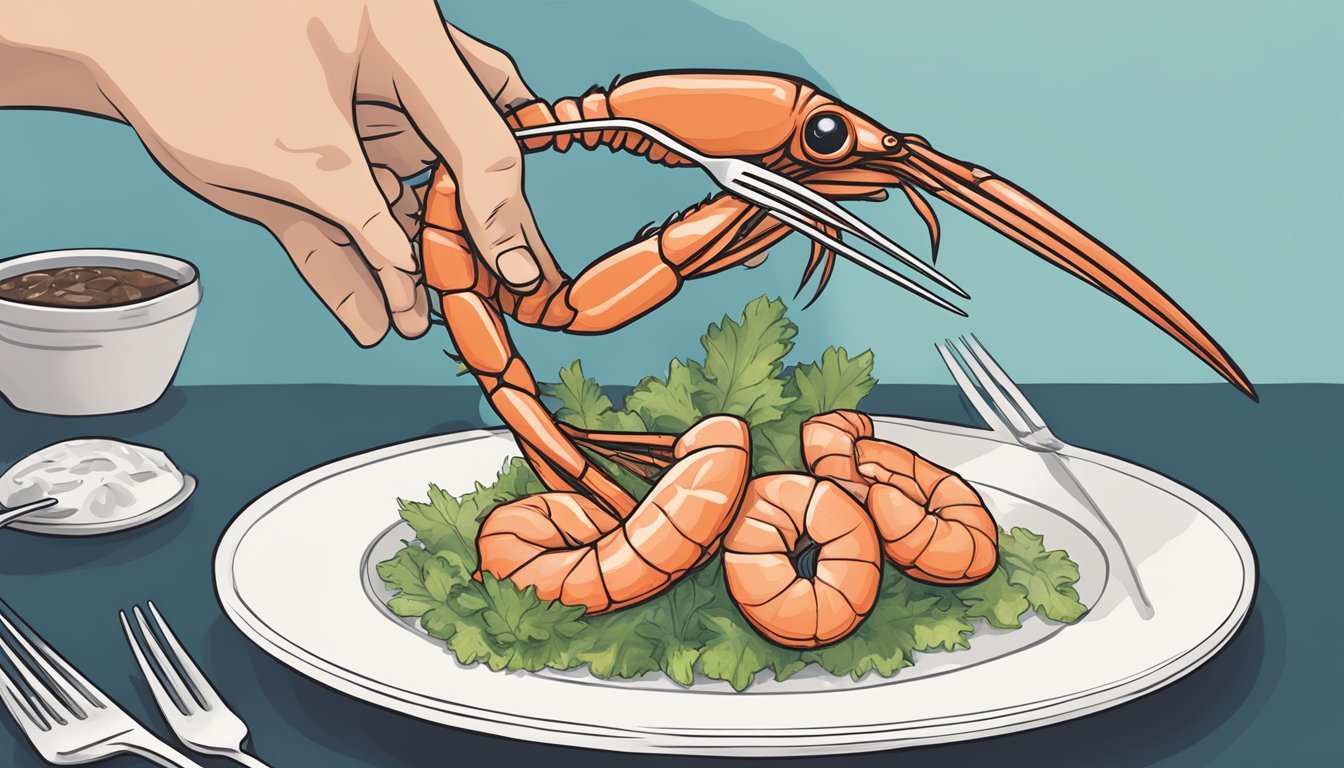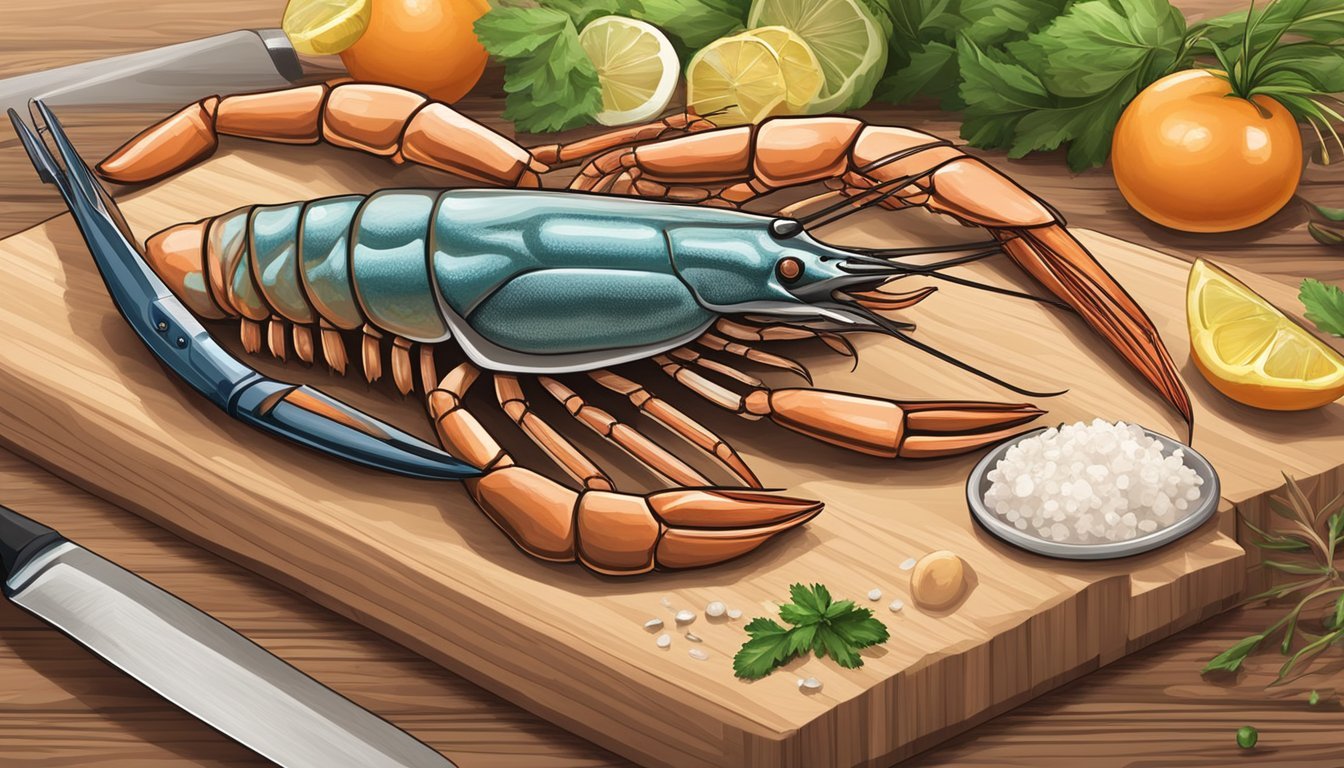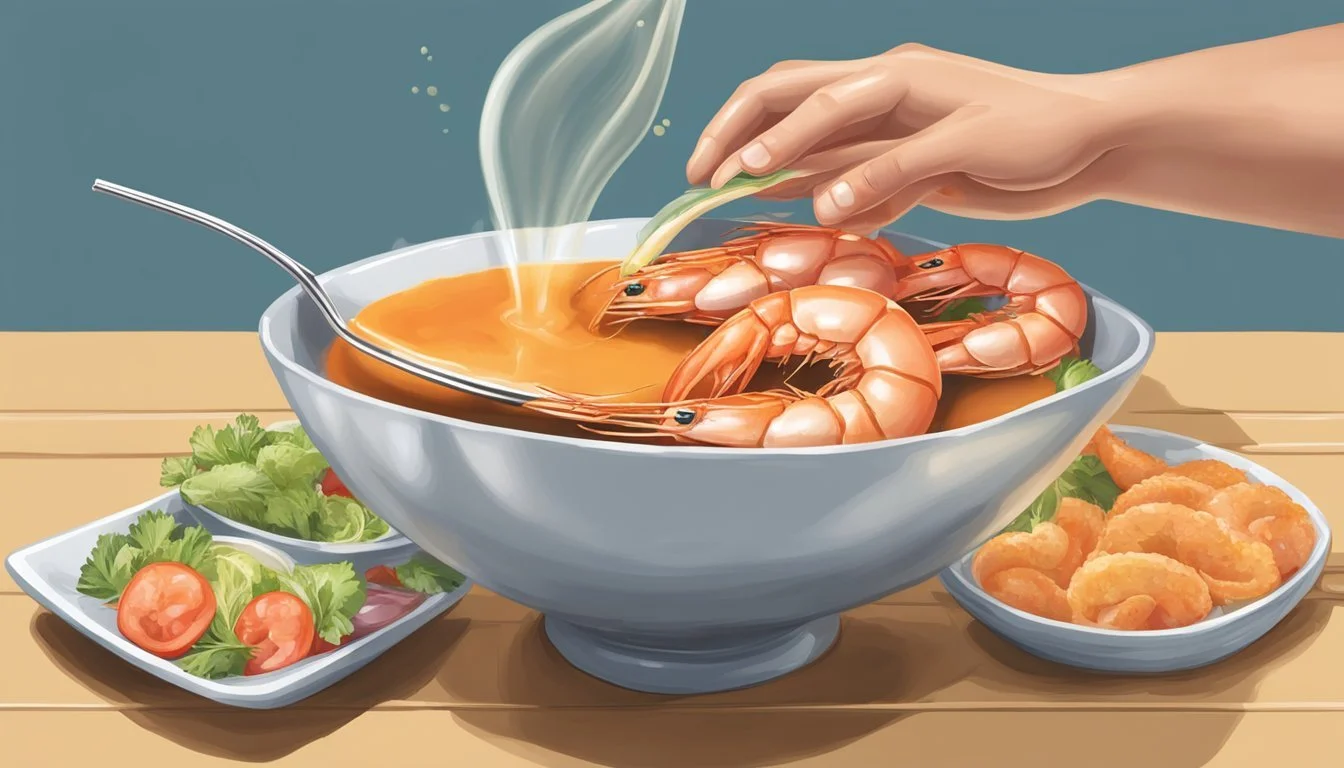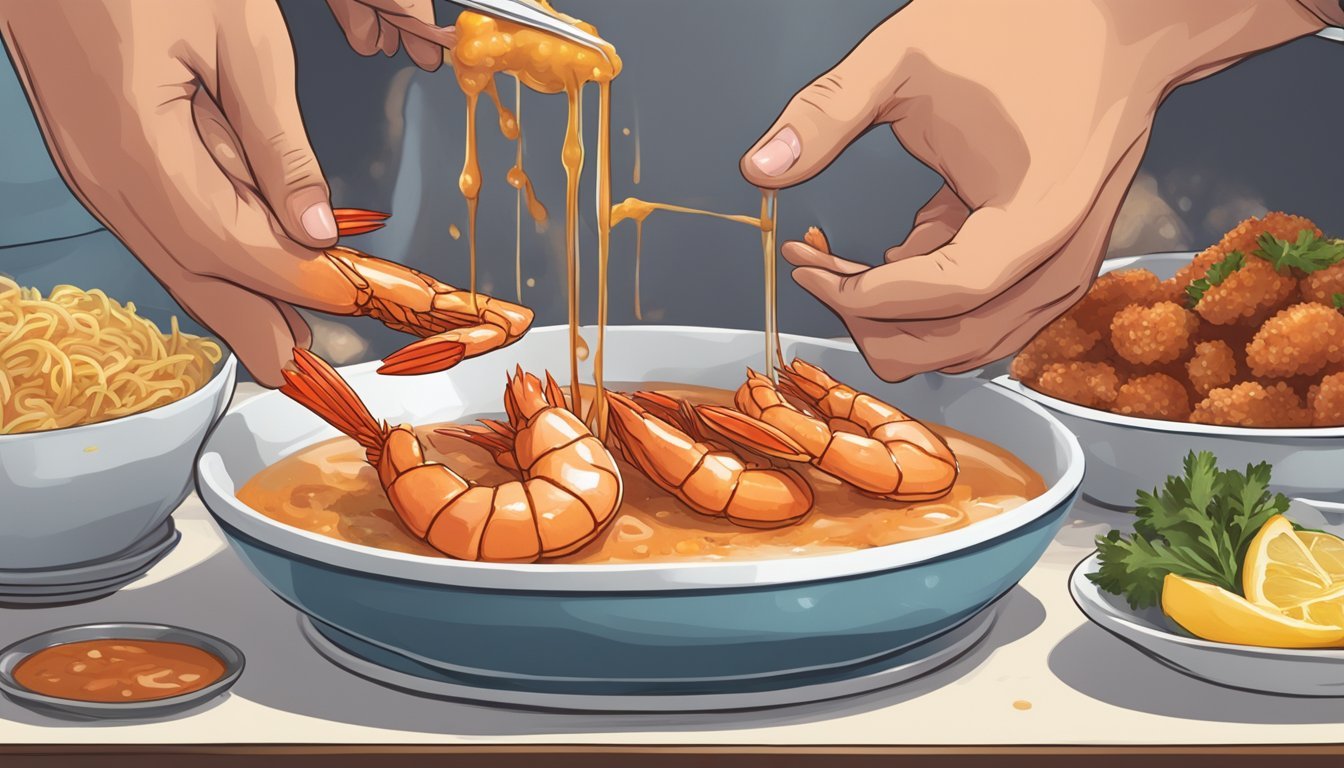How to Eat a Jumbo Shrimp:
A Step-by-Step Guide
Jumbo shrimp are a popular seafood choice known for their larger size and meaty texture. When it comes to eating jumbo shrimp, there are several methods and preparations to enjoy these succulent crustaceans. Whether grilled, baked, broiled, or boiled, jumbo shrimp can be served with a variety of seasonings, sauces, and accompaniments that enhance their natural, sweet flavor.
The experience of eating jumbo shrimp often begins with a decision on whether to prepare them with shells on or off. While cooking them in their shells can help retain moisture and flavor, peeling the shrimp beforehand allows for more direct seasoning of the meat. If served with the shell on, diners typically peel the shrimp at the table, removing the head, tail, and outer shell before savoring the tender flesh inside. In some dishes, such as shrimp cocktail, (What wine goes well with shrimp cocktail?) the shrimp are usually peeled and deveined before being served, allowing for an easy and elegant eating experience.
Regardless of the chosen preparation, it is essential to cook jumbo shrimp properly to ensure they are juicy and not rubbery. Overcooking can result in tough, chewy flesh, while the right cooking time brings out the best texture and taste. The larger size of jumbo shrimp means they require a slightly longer cooking time than smaller shrimp - usually just a few minutes on each side, depending on the method. Once cooked, jumbo shrimp are often garnished with herbs, lemon, or dipping sauces for an additional layer of flavor.
Identifying Quality Shrimp
When choosing jumbo shrimp, consumers should consider whether they are buying fresh or frozen, understand the sizing categories, recognize the indicators of freshness, and be aware of the nutritional content.
Fresh Vs. Frozen Shrimp
Fresh shrimp should have a consistent texture and a slightly salty scent reminiscent of the ocean. They should be stored in a refrigerator and consumed within a day or two of purchase. Frozen shrimp, on the other hand, are a convenient option and can be stored in the freezer for several months. When defrosted, they should not smell sour or have ice crystals, which may indicate that they have been frozen for a long time or thawed and refrozen.
Understanding Shrimp Sizes
Shrimp are sold by size, and the terminology can vary. However, large shrimp typically contain about 31-35 pieces per pound, and jumbo shrimp have approximately 21-25 pieces per pound. When buying shrimp, one should check the label for the count per pound to ensure it aligns with these general size classifications.
Recognizing Freshness Indicators
Fresh shrimp should appear translucent and shiny with a firm texture. They should be free of any ammonia-like odors—an indication that the shrimp may be past their prime. The flesh should be notably pink to white in color and should turn more opaque when cooked. If the heads are on, their presence can ensure extra flavor, but the heads should be firm and the eyes should be intact and not cloudy.
Nutritional Information
Shrimp are lean protein sources, with a 3-ounce (approximately 85 grams) serving containing about 84 calories and less than 1 gram of saturated fat. A serving of large or jumbo shrimp generally offers valuable nutrients such as iodine and selenium. It is important to refer to the nutrition facts on the package for specific information, especially when considering dietary restrictions or goals.
Preparation Before Cooking
Proper preparation is crucial to ensure that jumbo shrimp are clean, flavorful, and cooked to perfection. Each step must be executed with care to enhance the dining experience while ensuring safety.
Thawing Frozen Shrimp
Frozen shrimp should be transferred from the freezer to the fridge to defrost slowly, taking about 24 hours per pound. An alternate method is placing the shrimp in a colander under cold running water for a quicker thaw.
Cleaning and Deveining
To clean shrimp, one should first remove the shell by peeling it away from the body. Deveining involves making a shallow cut along the back to extract the dark vein. Rinse the shrimp under cold water and pat them dry with a paper towel.
Marinating for Flavor Enhancement
Marinating shrimp can greatly enhance their flavor. A mixture of olive oil, lemon juice, and select seasonings such as garlic provides a flavorful base. Shrimp should marinate for 15 to 30 minutes to absorb these flavors without becoming mushy.
Seasoning and Spicing
To season shrimp, a blend of salt, pepper, garlic powder, onion powder, and a hint of cayenne pepper can add depth. The ideal is a balanced coating that complements the shrimp's natural brininess.
Preventing Overcooking
Avoiding overcooking is essential to prevent shrimp from becoming rubbery. Cooking times vary by method, but generally, jumbo shrimp cook through in about 3 to 6 minutes.
Shrimp Handling and Safety
Shrimp should be handled with cleanliness in mind to prevent foodborne illness. Always wash hands before and after handling raw shrimp, and ensure that all utensils and surfaces are clean.
By attentively following these steps, you will be well-equipped to cook jumbo shrimp that are both safe to eat and delicious.
Cooking Techniques
Jumbo shrimp offer a versatile canvas for a variety of cooking techniques, each infusing the shellfish (What wine goes well with shellfish?) with distinct flavors and textures. To ensure a succulent outcome, precise cooking times and appropriate methods are paramount.
Boiling and Serving
One initiates the boiling process by heating water to a rolling boil before reducing the heat to a medium level to maintain a gentle simmer. The shrimp then cook in this hot water for approximately 3 minutes. For a traditional shrimp cocktail, one can transfer the boiled shrimp to an ice bath to halt the cooking process. This technique results in a firm texture, primed for dipping in cocktail sauce.
Grilling for a Smoky Flavor
Grilling gives shrimp a smoky char that enhances their natural flavors. They skewer the jumbo shrimp and place them on a hot grill, cooking each side for about 2-3 minutes until a light char appears. One can baste the shrimp with garlic butter for added flavor, creating a dish commonly known as grilled garlic butter shrimp.
Sautéing with Seasonings
To sauté shrimp, chefs heat oil in a pan before adding the shrimp to cook until they turn pink and opaque, usually about 2-3 minutes per side. One can season the shrimp with garlic, herbs, and spices which infuse quickly into the meat due to the high direct heat of the sauté pan.
Baking in the Oven
Baking jumbo shrimp in a preheated oven at a temperature around 400°F (200°C) is an uncomplicated method that yields evenly cooked, moist shrimp. They spread the shrimp in a single layer on a baking sheet and bake for 6-8 minutes, adjusting the time based on the shrimp size and the oven's specific characteristics.
Frying for a Crispy Texture
Frying in hot oil transforms jumbo shrimp into a crispy delight. Cooks dredge the shrimp in seasoned breadcrumbs before immersing them in oil heated to high temperature. This cooking method results in golden-brown fried shrimp with a crunchy exterior and tender interior, usually ready in 2-3 minutes per side.
Serving and Presentation
A jumbo shrimp meal elevates any dining experience with its versatility in presentation and flavor pairing. The following best practices ensure a delightful presentation and savory harmony at your meal table.
Plating Techniques
Shrimp can be plated both with and without the shell, depending on the dish. When serving with the tail on, diners often enjoy the aesthetic and may use the tail as a handle. Arrange the shrimp in a single layer on a plate or in a large bowl. If desired, add a lemon wedge for both visual appeal and as a zesty flavor enhancer.
Pairing with Sides
Complement jumbo shrimp with sides that enhance their delicate flavor. A bed of rice or a medley of roasted vegetables provides a balanced meal, while not overpowering the shrimp's natural taste. The sides should occupy a portion of the plate that doesn't overshadow the shrimp, maintaining them as the meal's centerpiece.
Sauce Selections
Offer a variety of sauces to cater to different palates. Classic cocktail sauce usually includes a tang of horseradish and adds a spicy kick. For those preferring a richer accompaniment, garlic butter is a sumptuous option. Sauces should be served in ramekins or small dishes on the side.
Serving Temperature
Shrimp are versatile and can be served warm or cold. The jumbo shrimp should be presented at the intended temperature immediately after preparation for the best quality and taste. For instance, shrimp cocktail is typically served cold, while grilled shrimp are served warm.
Portioning Considerations
Portion size is critical. As an appetizer, 5-6 jumbo shrimp per person might suffice. When shrimp is the main dish, 4 ounces per adult and 2 ounces for small children are reasonable serving sizes. Use decorative touches, such as single shrimps on small skewers, for appetizer portions.
By adhering to these serving and presentation guidelines, one can ensure that their jumbo shrimp are served in a manner that enhances the overall dining experience.
Eating Jumbo Shrimp
Eating jumbo shrimp involves mastering the art of peeling and utilizing utensils, understanding the etiquette of the tail, and enhancing the delicacy with sauces. Proper techniques ensure a delightful and hassle-free dining experience.
Peeling the Shell
One begins by removing the shell of the jumbo shrimp. They should use their hands to carefully take off the shell, starting from the underside where the legs are attached. It's often advisable to leave the tail intact as it can serve as a handle while eating.
Using Utensils Appropriately
In formal settings, diners should use a fork and spoon to peel and eat shrimp. To remove the shell with utensils, they first pierce the back of the shrimp with a fork, stabilize it on the plate, and use the spoon to gently detach the shell.
The Tail: To Eat or Not to Eat
The tail of the jumbo shrimp is not typically consumed but can be used to hold the shrimp while eating. To remove it, they can squeeze the end of the tail and pull the flesh out. It's a matter of personal preference whether or not to consume the tail.
Dipping and Enhancing Flavor
Enhancing the flavor is key. Diners often dip the peeled shrimp into sauces like cocktail or tartar. A squeeze of lemon juice may also be added for extra zest.
Cultural Etiquette
Each culture may have its own etiquette for eating jumbo shrimp. It's important to observe and adapt accordingly, whether it's using hands in casual settings or utensils in more formal occasions.
Common Questions Answered
Can you eat the tail? While the tail is typically not eaten, it is not harmful if consumed.
Is it better to peel with hands or utensils? Hands are suitable for casual dining, but utensils should be used in formal settings.
What sauces pair well with jumbo shrimp? Classic options include cocktail sauce, tartar sauce, or a simple mix of lemon juice and melted butter.
After the Meal
Once a diner has enjoyed their jumbo shrimp, attention turns to post-meal etiquette and safety, ensuring nothing goes to waste and leftovers are handled properly.
Proper Disposal of Shells
When one has finished eating jumbo shrimp, shell disposal should be immediate. Shells should be placed in a waste container to avoid unpleasant odors. If composting is an option, shrimp shells are a great addition, as they add calcium to the compost pile.
Storing Leftovers Safely
Leftover cooked shrimp should be stored properly to maintain their taste and safety. They should be cooled to room temperature quickly and then placed in an airtight container. Store them in the refrigerator at a temperature below 40°F to avoid bacterial growth.
Reheating for Best Quality
When reheating shrimp, it's paramount to preserve their texture and flavor. The oven or stovetop is ideal for reheating. One should heat them until just warm, being careful not to overcook, as this can lead to rubbery shrimp.
Oven method: 275°F for 10-15 minutes.
Stovetop method: On low heat, in a skillet with a cover, until warm throughout.
Creative Uses for Leftover Shrimp
Leftover shrimp can be transformed into new meals. Adding them to a salad brings a protein boost and a different light taste. Incorporating into pasta dishes or warm shrimp rolls can revitalize the leftovers into delightful dishes. It's a sustainable approach to ensure all food is utilized.







